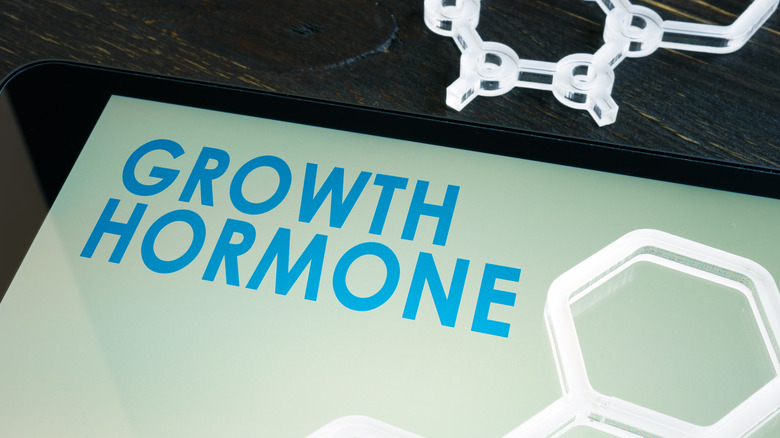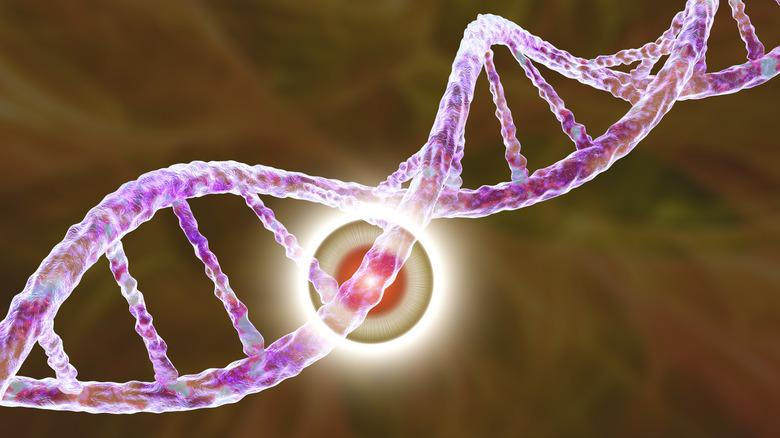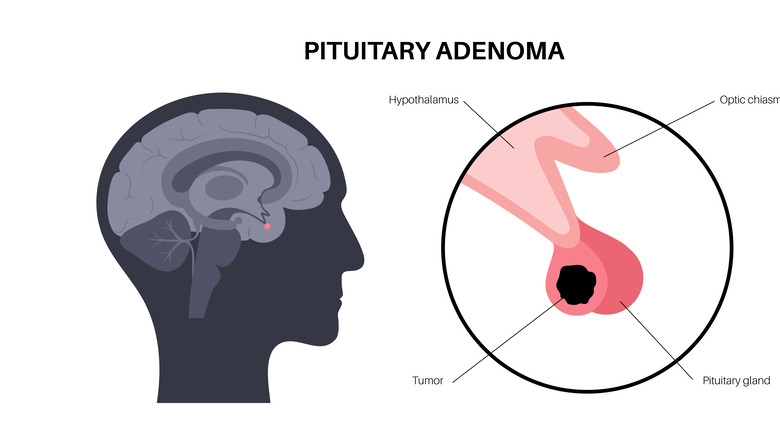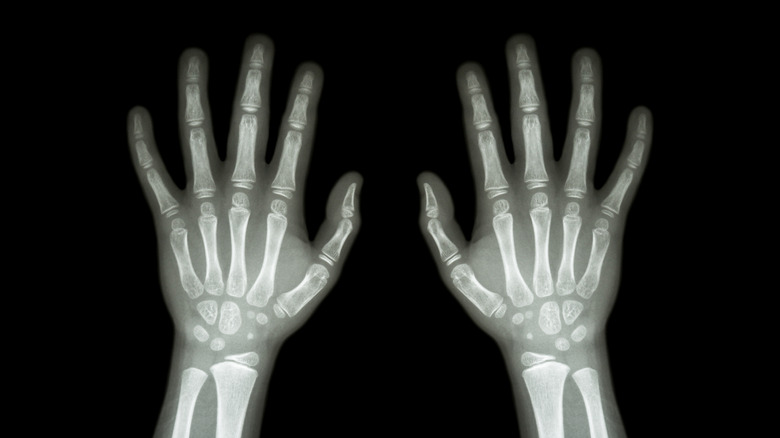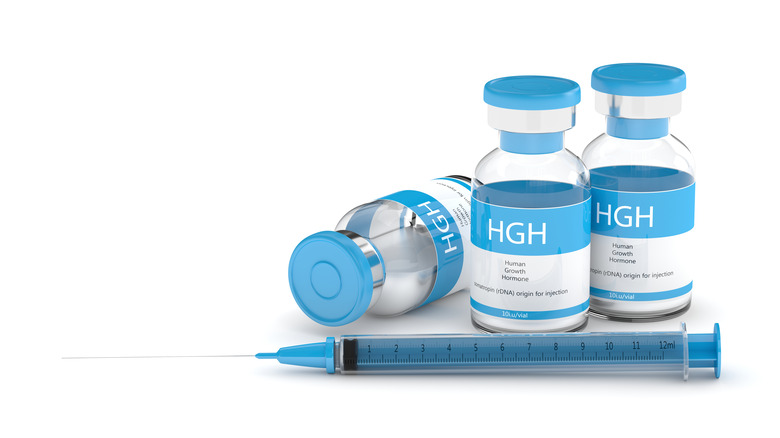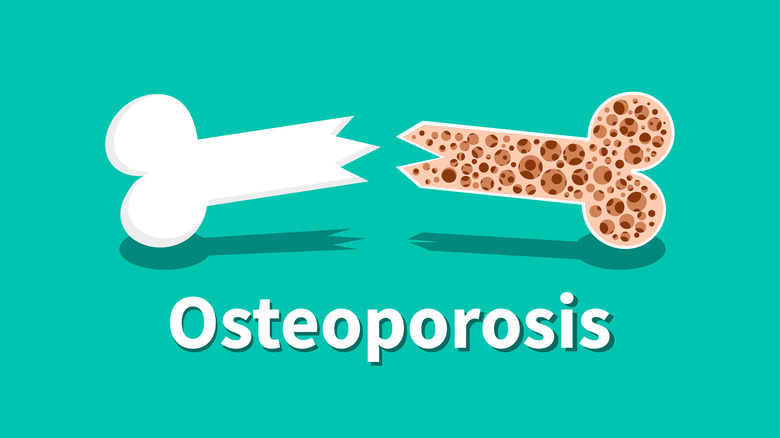Growth Hormone Deficiency Explained: Causes, Symptoms, And Treatments
Growth hormone deficiency (GHD) is an uncommon condition caused by insufficient production of growth hormone by the pituitary gland, explains the Cleveland Clinic. GHD can be present at birth or it can develop during childhood or adulthood as a result of damage to the pituitary gland. In some cases of GHD, the cause remains unknown. A lack of growth hormone slows normal growth in infants and children. Consequently, children with GHD do not grow as tall as they otherwise might, though their bodies are proportionate.
After a person stops growing, growth hormone continues to play a key role in maintaining normal body structure and metabolism. In adulthood, GHD causes metabolic problems such as increased body fat and high blood sugar levels. While some individuals with GHD still continue to produce some growth hormone, others do not produce any growth hormone, reports Boston Children's Hospital. Fortunately, GHD is a treatable condition, notes Healthline. Injections of synthetic growth hormone given at home have been used very successfully since the mid-1980s. Children who are diagnosed and treated early can reach a normal height and avoid delayed puberty. Some children may need growth hormone injections only until puberty, while others may require ongoing injections throughout their life.
Functions of growth hormone
Growth hormone (GH) is a produced and secreted by the pituitary gland — a small, pea-sized endocrine gland situated at the base of the brain, reports the National Institutes of Health (NIH). The main function of GH is to directly promote growth in bone and cartilage. GH also works indirectly by stimulating the liver to produce and release IGF-1 (insulin-like growth factor-1), another hormone that drives the growth of both bone and cartilage. Correspondingly, GH levels are highest during childhood and adolescence, when the body is growing the most. Then levels go down as we get older.
According to a 2019 review published in the journal Signal Transduction and Targeted Therapy, GH also helps balance electrolytes and plays a role regulating the metabolism of amino acids (protein), carbohydrates, fats, and minerals. For example, GH preserves muscle mass and strength by helping the muscles to take in amino acids and hang onto nitrogen, thus favoring a positive protein balance. GH also reduces body fat by stimulating the breakdown of stored fat and by counterbalancing the action of insulin via inhibition of glucose absorption into fat cells. GH also plays a role in our immune system, cardiovascular system, the growth and development of nerves, and the aging process. Due to the many varied actions of GH, many tissues and organs are affected when GH levels are altered.
Types of growth hormone deficiency
According to the Cleveland Clinic, growth hormone deficiency (GHD) is categorized into three main groups: congenital GHD, acquired GHD, and idiopathic GHD. Congenital GHD exists at birth and results from mutations in genes that may play a role in brain development as well as in midline facial birth defects such as cleft palate. In some cases of congenital GHD, the pituitary gland is abnormally small or absent, reports Medical News Today. Though uncommon, congenital GHD may sometimes be inherited.
Acquired GHD can develop during childhood or adulthood and is a consequence of injury to the pituitary gland (hypophysis), explains the Endocrine Society. Pituitary damage may be caused by a number of factors affecting the brain such as tumors, surgical procedures, head trauma, or radiation of the brain area associated with cancer therapy. On rare occasions, acquired GHD may be induced by hypophysitis — inflammation of the pituitary gland often linked to certain cancer treatments. Some individuals with acquired GHD may be lacking in other pituitary hormones as well; however, most children do not have additional hormone deficiencies. Slow growth and below-average height in children may be due to factors other than GHD, explains the Endocrine Society. It may just be a normal and transient phase that precedes the beginning of puberty. Nevertheless, the typical yearly growth rate for children with GHD is less than 2 inches. In people with idiopathic (or isolated) GHD — the third type of GHD — the cause is not known.
Prevalence of growth hormone deficiency
There is a large variation in the prevalence of growth hormone deficiency (GHD) in both children and adults, ranging from 4.6 to 40.6 per 100,000 persons, reports a 2014 study published in the journal BMC Research Notes. Likewise, the incidence (the occurrence of new cases each year) of GHD varies widely from 1.2 to 33 per 100,000 persons. Each year, roughly 6,000 American adults are diagnosed with GHD (includes transition of childhood GHD into adulthood). As noted by the NIH, adult growth hormone deficiency is associated with an increased prevalence of certain disorders. For example, adults with GHD have an increased prevalence of risk factors for heart disease, including insulin resistance, obesity, high blood pressure, and elevated levels of total cholesterol and LDL cholesterol as well as low levels beneficial HDL cholesterol. Studies have shown that individuals with both adult-onset and childhood-onset GHD have increased plaque formation in large arteries. Adult GHD is also linked to increased fracture rates.
Signs and symptoms of growth hormone deficiency
In children with GHD, growth in height is slowed, resulting in short stature compared to peers, reports Healthline. Their faces appear younger and rounder while their bodies tend to be chubby (particularly around the abdomen) despite normal body proportions. If GHD is acquired in late childhood, puberty is delayed and sometimes sexual development is impaired, e.g., lack of breast development in young women or absence of voice deepening in young men. Children with GHD have reduced bone strength and may experience fatigue, poor stamina, sensitivity to hot or cold, depression, lack of concentration, poor memory, and episodes of anxiety. Symptoms of GHD in newborns, according to Medical News Today, include low blood sugar, a small penis, and delayed closure of the fontanelles (soft spots of a newborn's skull). Among other symptoms of GHD in children are fine hair, reduced nail growth, and a high voice.
Adults who acquire GHD may notice an unexpected shift in body composition resulting in decreased muscle mass and an increase in body fat, especially around the belly. Like children with GHD, adults with GHD may have low energy levels, depression, anxiety, and diminished bone strength. As described by Endotext, adult GHD is associated with adverse effects on cardiovascular and metabolic health. Adult-onset GHD is also linked to a lower quality of life, e.g., depression, poor self-esteem, social isolation, and poor concentration.
Causes of growth hormone deficiency
The causes of growth hormone deficiency (GHD) depend on whether a person was born with the condition or acquired it later in life (via the Cleveland Clinic). Congenital GHD is caused by genetic mutations that affect the production and action of growth hormone (GH) in the body. For example, isolated growth hormone deficiency type IA is a genetic mutation characterized by delayed growth of the fetus and abnormally small size of the infant at birth. At some point after initiation of treatment with synthetic growth hormone, people with type IA produce antibodies to GH, thus further impeding growth and resulting in a very short adult height. While type IB mutation resembles type IA, synthetic GH treatments remain effective throughout life in type IB. In people with type II and type III GHD, GH levels are very low and short stature becomes noticeable in early to mid-childhood. However, people with type II mutation are at greater risk of infections due to weakened immune function.
As noted by Endotext, pituitary adenomas — benign growths on the pituitary gland — are the leading cause of adult GHD. Along with craniopharyngiomas (benign tumors near the pituitary gland), pituitary adenomas are responsible for 57% of adult GHD cases. Infections and inflammatory disorders can also induce adult GHD. Additional causes include traumatic brain injury (TBI), autoimmune disease, radiation therapy, brain surgery, and certain drugs.
Risk factors for growth hormone deficiency
For the most part, growth hormone deficiency (GHD) cannot be prevented, reports the Cleveland Clinic. The risk of developing GHD in childhood is increased by factors such as trauma to the brain through injury, radiation, or surgery. According to a 2020 study published in the Journal of Clinical Oncology, childhood cancer survivors were found to have a significantly greater risk of GHD and abnormally small height in adulthood. Impaired growth affects an estimated 10-20% of survivors of childhood cancer. Specific factors that increased the risk of GHD among the cancer survivors include young age at treatment, small height at diagnosis, brain tumor, and radiation treatment. Brain tumors impact growth hormone levels directly as well as indirectly by causing fluid buildup in the brain. Significant radiation of the pituitary gland appeared to double the risk of small adult height. As noted by the study authors, other risk factor for growth hormone deficiency in childhood include early puberty, dialysis, low thyroid, and scoliosis. Growth hormone deficiency and short stature are also more frequently observed in children with cleft palate relative to peers, notes a study published in a 2012 edition of the journal Pediatric Research.
Diagnosis of growth hormone deficiency
The diagnosis of growth hormone deficiency (GHD) in a child begins with a medical history and measurement of height against growth charts (via the Endocrine Society). A height decrease across two or more percentiles with normal body proportions and body weight may suggest GHD. If the clinical exam and history indicate poor growth, a number of tests may then be performed to determine the cause of slow growth. As described by the Merck Manual, X-rays are often taken of the bones in the child's hand to assess bone development. Delayed bone development suggests GHD, though it is also a sign of low thyroid and delayed puberty.
Blood levels of growth hormone (GH) are not measured directly because they are highly variable and secreted in pulses throughout the day. Indirect measurement of markers of growth hormone function are thus preferred. These GH markers are substances that are stimulated by GH and include IGF-1 and insulin-like growth factor binding protein-3 (IGFBP-3). Other causes of GHD (such as underlying problems with the thyroid, blood, or kidneys) are ruled out with other blood tests. An MRI imaging scan of the brain is done to detect pituitary damage and tumors. A stimulation test may also be performed whereby GH levels are measured after administering drugs that stimulate GH production. In most adults with suspected GHD, a stimulation test is required to confirm a diagnosis, according to a 2013 study in Nature Reviews Endocrinology.
Medical treatment of growth hormone deficiency
Growth hormone deficiency in children is treated with growth hormone (GH) replacement therapy, reports the Endocrine Society. This involves daily injections of synthetic human growth hormone given at home subcutaneously at bedtime. A once weekly injection of a slow-release GH formulation is another treatment option. Children receiving GH injections are regularly monitored by their physician for growth response, changes in IGF-1 blood levels, and bone age as determined by X-rays. Therapy with GH continues until the child stops growing and reaches adult height. Some children grow four inches in height in just the first year of therapy. Ultimately, a normal adult height can be achieved with GH treatment, especially if initiated early on. In most cases of childhood-onset GHD, GH treatment does not need to be sustained through adult life. Though the benefits of GH injections outweigh the risks, some mild to moderate adverse effects can occur. These include headaches, muscle or joint pain, slightly low thyroid, swollen hands and feet, and deterioration of scoliosis. Severe side effects (e.g., pancreatitis, sleep apnea, severe headache affecting vision) are uncommon.
As recommended by the National Institute for Health and Care Excellence (NICE), treatment with human growth hormone should be reserved only for adults with severe GHD where quality of life is significantly diminished (via Endotext). Within three to six months, replacement therapy with GH results in improved quality of life in greater then 90% of adult patients.
Complications of growth hormone deficiency
According to Boston Children's Hospital, growth hormone deficiency (GHD) on children can lead to complications such as low energy, lower bone mineral density, and more cardiovascular risk factors. Short stature (with normal body proportions) associated with GHD has complications of its own, notes Medical News Today. As an adult, an individual with short stature has a greater risk of osteoporosis, diminished muscle strength, and heart problems. In addition, they may have issues with some internal organs, and women with the condition may experience pregnancy complications and have to deliver by cesarian section. Complications in adults with GHD include cardiovascular events such as stroke and heart attack, according to a 2014 study published in the journal Neurologia medico-chirurgica. GHD in adults is also associated with a greater incidence of non-alcoholic fatty liver disease. A higher risk of premature death is associated with cardiovascular complications in adult-onset GHD, thus shortening life expectancy.
Living with growth hormone deficiency
Growth hormone deficiency (GHD) in children presents a substantial burden that is not confined to abnormally short height, explains a 2017 study published in the journal Quality of Life Research. Other symptoms may impact the daily life of children with GHD. These include diminished appetite, poor strength or muscle development, low energy levels, lack of endurance, insomnia, fatigue, and poor focus or concentration. These symptoms exacerbate the negative physical and social effects of short stature in children with GHD, making them even more noticeably different from their peers. For example, some children may have difficulty reaching things or may not perform as well in physical activities or sports. Others are affected by the social impacts of the condition, including being mistaken for a younger age, teasing or bullying, being treated differently by others, social anxiety, and choosing not to participate or being excluded from activities. For many children with GHD, continues the study, emotional well-being is negatively impacted. Feelings of embarrassment, anger, poor self-confidence, sadness, annoyance, frustration, nervousness are often reported by these children.
As described by a 2014 study published in BMC Research Notes, adults also experience a considerable physical and psychological burden from having GHD. Adult GHD is associated with weight gain, insomnia, and fatigue, as well as loss of energy, sex drive, hair, skin, muscle, bone, memory, and concentration. Other repercussions of adult GHD include negative effects on health, self-image, employment, educational attainment, social engagement, and general satisfaction in life.
Prognosis of growth hormone deficiency
Children with GHD who are diagnosed and treated early generally reach relatively normal height and development, reports the Society for Endocrinology. Ordinarily, treatment with growth hormone (GH) continues until the child finished growing. However, the child's physician may suggest continuing GH therapy until age 25 in order to maximize bone mass and muscle mass. Moreover, beyond its growth effects, GH is associated with a sensation of being robust and energetic. Nevertheless, regular follow-up visits as an outpatient are necessary to monitor growth. For adults with GHD, the prognosis is also good. As noted in a 2022 study published in the Journal of the Endocrine Society, adults with GHD have a positive outlook due to better energy levels and motivation, less fatigue, and enhanced mood and cognitive abilities. In addition, the ability of GH to increase bone and muscle mass leads to improved body composition.


